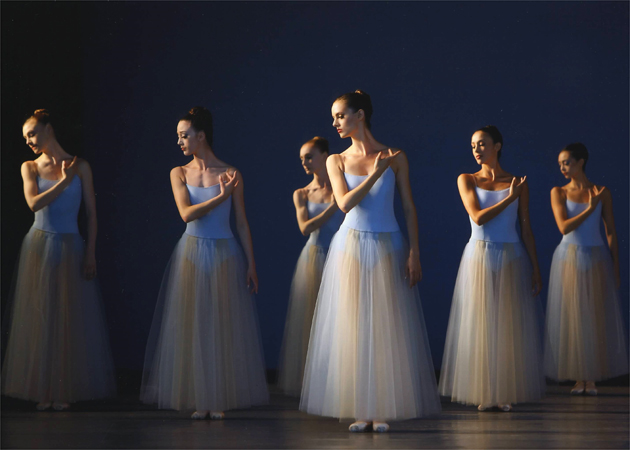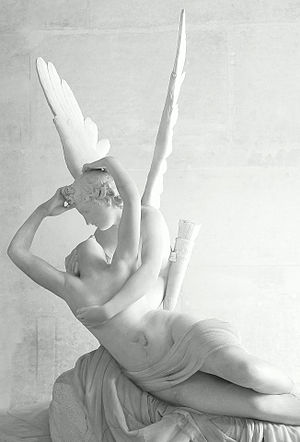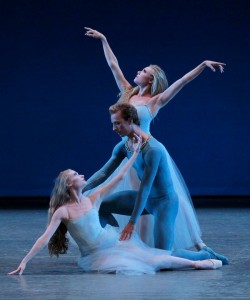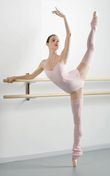Serenade begins in a calming blue darkness with seventeen women standing still, their right arms raised to shield their faces from what feels like moonlight. When Tchaikovsky’s opening musical phrase repeats they slowly move their arms in unison until their parallel feet snap to first position. Then, with their arms opened wide they arch backwards to the sky as the last chord trails off into silence. It is a balletic hosanna. From there the music picks up and the women begin to bend and shape themselves into little floral-patterned quartets (your math is correct, one girl simply runs off into the wings for much of the piece) and the stage becomes a swirling sea of blue tulle. But that tranquil, evanescent opening is so spiritually charged that it never fails to awe me.
It is roughly two minutes long and it summarizes the whole ballet—and also the entirety of human experience! The women’s arms float effortlessly, but the path they trace is heavy with meaning:
I was sad to miss dancing Serenade this time around, but ironically, it is a ballet that sometimes makes me sad. After the one-off gala night, Serenade opened this past fall season too. When the curtain went up and the major chords of the andante vibrated through the house I realized that it was the first time I was performing since my grandmother passed away in late August. I don’t think that any other ballet would have prompted that realization, but it hit me hard. I stood there with my arm raised as my eyes filled with tears; it was an intense experience. But I was grateful to have that moment, even onstage, of all places. During our summer residency in Saratoga Springs two years ago one of my young male colleagues lost his mother, so the cast dedicated a performance of Serenade to her. We formed a circle with him before the show and he said a few words in her memory. When the curtain rose we were all quietly crying.
Few ballets hit you as hard over the head with your own mortality as Serenade. Many other ballets are sublime to dance--Concerto Barocco, for example. But Barocco is more of an intellectual pleasure—the pleasure derived from complex precision in movement and music. It is also much more restrained in its movement quality. In Barocco you must keep yourself in check: match up your lines with the group, isolate your upper body from your feet. When the curtain falls everyone’s calves are burning and we can all finally exhale. Serenade is an altogether different animal. It is a full-bodied workout; your breath must flow with the movement. In Serenade you are up and down from the floor in every section, and you must bend your body as far as possible, travel as much as you can. In Barocco you would never sit on the floor! In Serenade one is physically and emotionally pushed to the limits.
Serenade is also very individualized. Except for the principal roles, which are clearly delineated from start to finish, no person has the same path through Serenade from start to finish. Even if you are one of the “Russian Girl” demi soloists, like I am, your place in the ballet is unique. After the waltz movement ends the Russian Girl roles become demarcated, but before that anything can happen. I have had probably eight different trajectories through the ballet over the course of my career, and when I come back from this injury my part will necessarily change again. I think three different people are covering my last spot right now. The corps women are always forced to change places in various sections because of height and other factors, and it can be frustrating to have to continually adapt to the shifting sands of the group. But I rather love that Serenade is such a mutable entity. It is like going back in time and choosing a different door in the course of your life. I have experienced many different paths through Serenade and some are much easier than others. Again, it is an apt metaphor for life.
Serenade is clearly about life and death, but there is no specific story per se. Balanchine switched the order of the last two movements of Tchaikovsky’s Serenade for Strings, so the ballet ends with the elegy instead of the jubilant allegro that concludes the score in concert halls. There is an ominous figure called the Dark Angel, several women who fall to the floor, and lots of imagery borrowed from the Orpheus tale (a man repeatedly walks towards one woman while another woman shields his eyes). It also features a recreation of Antonio Canova’s famous 1787 sculpture Psyche Revived by Cupid’s Kiss, which depicts the moment when Psyche is awoken from the sleep of death by her lover. And the ballet ends with the lead woman being carried aloft on a chariot of men into the light, stopping to hug a figure we call “the mother” before she ascends.
I find it amazing that Balanchine made a work of this emotional intensity on students, as part of an exercise, back in 1934. He didn’t have a company yet so he simply worked with whoever showed up for lessons on any given day. The ballet has morphed quite a bit over the years, with expanded musical repeats, and the principal women taking their hair down for the elegy was added later too. But Balanchine claims he was just responding to the music, as always. And with Serenade he was working with Tchaikovsky, with whom he felt he maintained an intense closeness—even though Tchaikovsky died a decade before Balanchine was born. In Solmon Volkov’s 1985 book of interviews, Balanchine’s Tchaikovsky, Balanchine says, “[m]y feelings for Tchaikovsky were different, even as a child. Imagine yourself in a church and suddenly the organ starts playing overwhelmingly grand music in all its registers. And you stand there mouth agape in astonishment. That’s how I always felt about Tchaikovsky. He’s like a father to me.”
In another passage, Balanchine discusses the intensity of their collaboration: “of course, Tchaikovsky is always with us….In everything I did to Tchaikovsky’s music, I sensed his help....When I was doing Serenade, Tchaikovsky encouraged me. Almost the whole Serenade is done with his help.” Balanchine’s kindred ties to Tchaikovsky ring true in Serenade. Both men were extremely pious, and both understood the ineffable power of art. Volkov quotes Balanchine: “Music contains profound feelings and emotions; people are born and die with them, but they can’t explain them.” I was not raised with any religious affiliation, and I have never experienced a transcendent connection in a church or a temple. But I do feel deeply spiritual in relation to specific pieces of art, and Serenade is one of the most sacred examples. With Serenade, Balanchine's and Tchaikovsky's gifts coalesced to forge an altar for the secular.




 RSS Feed
RSS Feed